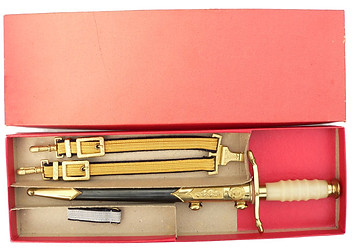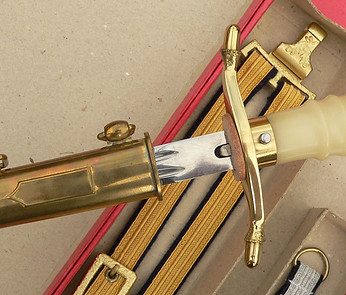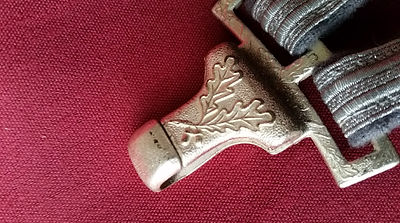
Officers Honor Daggers of the NVA
By Lee Stewart
Reprinted from the SEGMC Journal
Die Nationale Volksarmee
Issue #13 - Fall 1996
One of the distinctive items of the officers’ parade uniform of the Nationale Volksarmee which immediately draws attention, and which has rapidly caught on as collector’s item, is the honor dagger (Ehrendolch). Although the standard daggers for officers below general officer rank were virtually the same for all services, there were distinct differences in those for generals and admirals. This article will address only the honor daggers for company and field grade officers.

At first glance this item is very reminiscent of the daggers seen in great profusion during the Nazi era. The NVA however, having avowedly rejected all aspects of this period of German militarism, claimed a lineage for the honor daggers which predated the World War II period. Instead, the NVA claimed the origin of its honor daggers as the midshipmen’s daggers of the mid-18th century. These were worn in the place of full swards, which tended to get hung up in the ropes and rigging in the close quarters on the deck of a ship. By the time that the NVA adopted daggers, they had evolved into an item of ornamentation only, with no practical purpose. They were merely a symbol of officer status.
The term honor dagger is somewhat of a misnomer. Rather than being awarded for some specific action or accomplishment, they were standard for all officers. Male officers that is, they were not authorized for female officers. One source has claimed that female officers were authorized in 1986 to carry honor daggers, but this is not reflected in the Ministry of National Defense Uniform Regulation, DV010/0/005, dated 1986.
Although honor daggers had been authorized since 1957, the design development and selection process were very slow and they were not introduced in the NVA until 1961. They first appeared in public during the May Day parade in Berlin, 1 May 1961. The sale and registration of honor daggers was governed by the Ministry of National Defense Regulation 22/61, effective 26 April 1961. When first introduced, honor daggers were not an issue item. They had to be purchased by the individual officer which was not very popular, the price for the basic officers’ model being approximately 100 DDR Marks. However, in the 1970s the senior leadership of the NVA made it mandatory to wear the honor dagger for roll call formations (presumably the equivalent of our weekly reveille formation in the US Army) and it was a required uniform item for the parade uniform and the greater social uniform.

In 1975 honor daggers became an issue item for new lieutenants, being presented in a ceremony upon graduation from officers’ school. The class honor graduates received daggers which were engraved on the blade “For Outstanding Achievements (Fur Ausgezeichnete Leisunggen).” These were the only company/field grade daggers which were engraved.


According to Sylvia Lais (Ref. 1), the only manufacturer of honor daggers was the Produktionsgenossenschaft des Handels (PGH) Messerschmiede Muhlhausen in Thuringen, but they used up to 63 subcontractors. The blades were 252 mm in length, 17 mm in width, and made of 12 percent chrome steel. They were ground to a double edge, double grooved on both sides, and polished to a high sheen. All blades were left silver/steel in color regardless of the service they were made for. The serial numbers were stamped at the base of the blade nest to the guard, although some daggers manufactured prior the unification which were not serial numbered have been found. On the early daggers the manufactures’ trademark was stamped opposite the serial number. Later daggers did not have a trademark.

The fittings of the sheath were either silver or gold in color, depending on the service. The body of the sheath for all daggers was of brushed steel which was blued. The top fitting of the sheath had a stamped DDR state seal at the top. Below that was a bordered stippled area with an acorn and oak leaf design stamen into it. On the reverse side of the sheath there was an identical bordered area, unstippled and without the oak leaf design, on which the owner’s name could be engraved. According to Kurt Glemser (Ref. 2), there were some special presentation daggers which had “Presented by the Minister of National Defense (Uberreicht Vom Minister fur Nationale Vertiedigung)” engraved either on the reverse side of the upper sheath fitting or on the blued body of the sheath.
The hand guard and pommel of the ground Forces and Air Forces/Air Defense honor daggers were silver in color, presumably chromed. These pieces of the Volksmarine honor daggers were plated with a gold colored alloy. The end of the pommel of both daggers had a distinctive hammered design. The hand guard tips were stylized acorns, a traditional German design common to the hunting dagger. The handle of the officers’ dagger was made of molded cream colored plastic. The early handles had a marbled appearance while the later ones were uniform in color.




The belt loop and hanger for the officers honor dagger for the Ground Forces and Air Forces/Air Defense were made of silver colored aluminum braid on a stone gray underlay. However, there is information indicating that some early Air Force hangers had a light blue underlay. The hooks and buckles were frosted silver colored metal with an oak leaf pattern on a stippled background. The Volksmarine belt loop and hanger were identical in design to those of the other services but were of gold colored braid on a dark blue underlay and the fittings were plated in a gold colored alloy. There were several manufacturers of the belt loop and hanger and variations have been noted. According to Kurt Glemser (Ref. 2), some of the 1960s hangers had fittings which were identical to those used by the Wehrmacht. The common type of hanger was identical to that of the Luftwaffe second pattern dagger. There were also some minor variations on the pattern of the metallic braid.





The officers honor dagger was worn with several uniform combinations. With the parade uniform it was worn on the left side, hanging from the brocade belt. The brocade belt was worm over the tunic or, in winter, over the overcoat. When worn with the greater social uniform (Grosser Gesellschaftsanzug) or the walking out uniform (Ausgangsuniform) the hanger was worn under the tunic with the hanger hooked to a D-ring which was sewn inside the left side of the tunic. If the overcoat was worn, the hanger went through a slit under the left pocket flap and attached to a D-ring which was sewn to a web strap on the inside of the lining.

There were approximately 80,000 officers honor daggers produced in almost 30 years. The ministry of National Defense had origionally purchased daggers in five year cycles. But after daggers were made an issue item stocks rapidly ran out and in 1981 annual purchase of smaller lots of three to four thousand was instituted. Acording to Sylvia Lais (Ref. 1) the original manufacturer, now working under the name Jagd-Schneidwaren GmgH, stated that production of daggers ceased with the last delivery to the Ground Forces in 1990. However, assembly of honor daggers from stock parts continued until 1992. Production of hangers supposedly ceased in the fall of 1991 when the manufacturer ran out of the original material.
Referances:
-
Lais, Von Sylvia, “Zuviel der Ehre,” Visier, April 1991
-
Glemser, Kurt, A Guide to Military Dress Daggers, Vol. 1 and Vol. 2, Publisher Unknown, 1991
-
Keubke, Klaus-Ulrich, and Kunz, Manfred, Uniformen der Nationalen Volksarmee der DDR, Brandenburgisches Verlagshaus, Berlin, 1990
-
DV 010/0/005, Uniformen und ihre Trageweise, Bekleidungsvorschrift, (Uniform Regulation) DDR Ministry of National Defense, 1986.

